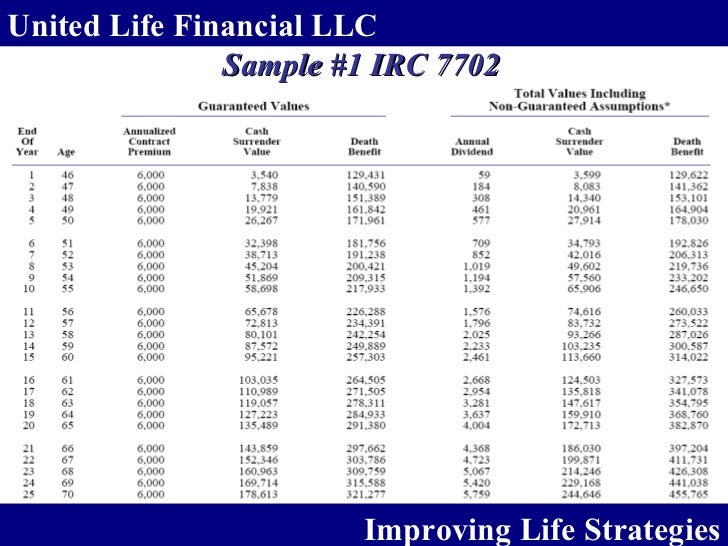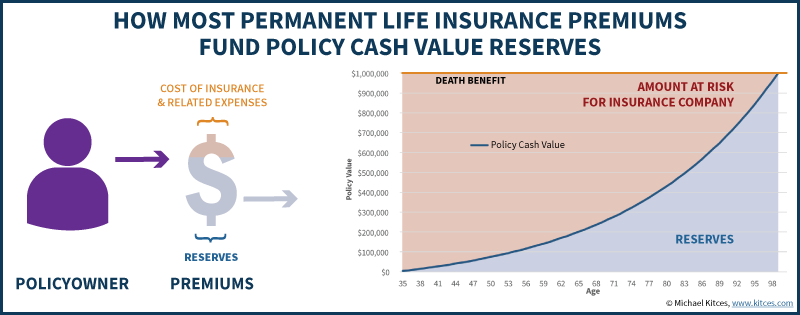
The fixed interest rates used in IRC 7702 calculations were enacted in 1984.After months of sitting in committee in the Senate, the Setting Every Community Up for Retirement Enhancement Act (SECURE Act) has been added to one of the year-end appropriations bills and passed by Congress. 2005-6 ISSUE For purposes of determining whether a contract qualifies as a life insurance contract under 7702 of the Internal Revenue Code and as a modified endowment contract under 7702A, should charges for qualified additional benefits (QABs) beThe New IRC 7702 Rules Did Congress Make Life Insurance More Affordable. Section 7702.Life Insurance Contract Defined (Also 7702A.) Rev.

Irc 7702 Code Is Applied
Section 401(a)(9) (IRC Section 401(a)(9)). Section 401(a)(1) of the Act adds a new subsection (H) to 26 U.S.C. Internal Revenue Code created the 7702 plan regarding how the tax code is applied to the accrual of cash in a life insurance policy, referred to as the cash value or. Modification of Required Distribution Rules for Designated BeneficiariesSection 7702 of the U.S. 101(g) a discussion of riders on a life insurance policy If your clients need both life insurance protection and a relatively affordable way to pay for potential long-term care costs, they may want to consider purchasing a life insurance policy and one of the two types of riders available: a long-term care rider (IRS section 7702B) or a.
The ten-year requirement appears to allow distributions over any schedule without required minimums during that ten-year period. While naming the surviving spouse outright as a beneficiary will permit stretch distributions, it is not clear from the Act whether a trust for the benefit of the surviving spouse and the children would permit the surviving spouse to qualify as an eligible designated beneficiary and if the trustee has the power to distribute to the children during the surviving spouse’s lifetime, it seems likely that the ten-year rule would apply.Minor Children: A minor child of the employee only receives eligibility status until reaching the age of majority then the child has ten years to distribute the remaining funds. The Act also does not does not change any of the provisions of IRC §408(d)(3), which governs rollovers (including spousal rollovers) at the death of the employee spouse. Under IRC §401(a)(9)(E) (amended under Section 401(a)(2) of the Act), an individual must fall into one of five categories to be an eligible designated beneficiary:(5) individuals who are not more than 10 years younger than the employee.Surviving Spouses: This Act continues to allow surviving spouses to distribute over their life expectancies. IRC §401(a)(9)(H)(i)(II).Distributions based on the life expectancy of the designated beneficiary (what we have commonly called “stretch distributions”) are now only allowed for a subset of beneficiaries called “eligible designated beneficiaries.” IRC §401(a)(9)(H)(ii). This is true whether or not the employee reached the required beginning date before death.
In addition to the requirement that a licensed health care practitioner certify that the individual meets the 7702B requirements, the new legislation also requires the certification based on ADLs under IRC §7702B(c)(2)(A)(i) to say that the limitation is indefinite but expected to be lengthy in nature. That section requires a licensed health care practitioner to certify one of three things:(i) being unable to perform (without substantial assistance from another individual) at least 2 activities of daily living for a period of at least 90 days due to a loss of functional capacity,(ii) having a level of disability similar (as determined under regulations prescribed by the Secretary in consultation with the Secretary of Health and Human Services) to the level of disability described in clause (i), or(iii) requiring substantial supervision to protect such individual from threats to health and safety due to severe cognitive impairment.IRC §7702B(c)(2)(A). See below for a summary of trusts for disabled or chronically-ill individuals that receive favorable treatment under the Act.Chronically-Ill Individual: Under paragraph IRC §401(a)(9)(E)(ii)(IV), an individual is “chronically-ill” if the individual meets the definition in IRC §7702B(c)(2)(A) (governing deductibility of long-term care expenses). Grandchildren, nieces, nephews, and unrelated or more distantly related minors are not eligible designated beneficiaries and must take distributions within ten years.Disabled Individuals: Under paragraph IRC §401(a)(9)(E)(ii)(III), to be “disabled” a beneficiary must meet the requirement of IRC §72(m)(7) (“n individual shall be considered to be disabled if he is unable to engage in any substantial gainful activity by reason of any medically determinable physical or mental impairment which can be expected to result in death or to be of long-continued and indefinite duration.”). (See the summary of the requirements for multi-beneficiary trusts below.) The same could be true for trusts naming a surviving spouse as one of multiple beneficiaries.Finally, because the Act does not remove the underlying Code provisions concerning designated beneficiaries but only limits the applicability to certain “eligible” designated beneficiaries, it appears that the requirements for creating see-through trusts to obtain deferrals will continue to apply, with the possible requirement that eligible designated beneficiaries be the only ones receiving distributions during their lifetimes.Note that the statute only permits minor children of the employee to be eligible designated beneficiaries. (In effect, upon the oldest beneficiary’s reaching the age of majority, the IRA would have to be distributed within ten years even if there are still minor beneficiaries.) The agency may interpret the statute to allow safe harbors for multi-beneficiary trusts similar to the safe harbors for trusts for disabled individuals where the trust terms call for immediate separation of trust accounts or provide for distributions only to the minor child during the minor child’s lifetime.
...



 0 kommentar(er)
0 kommentar(er)
